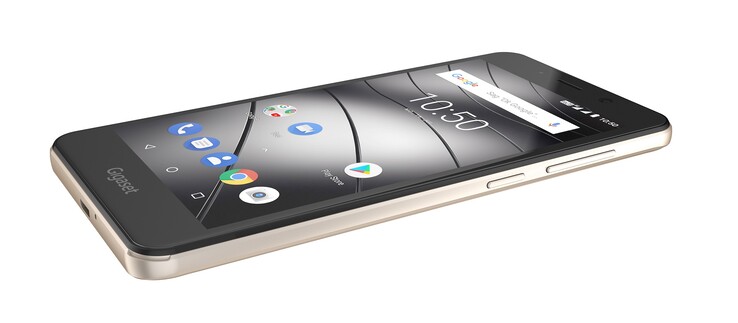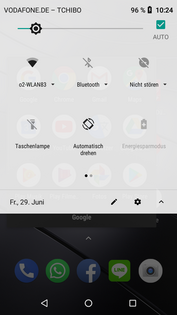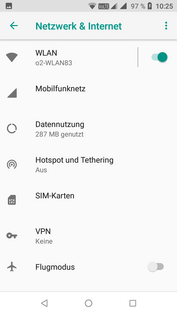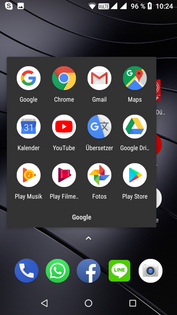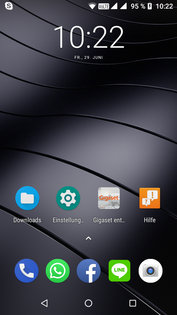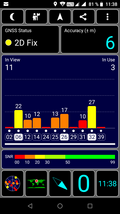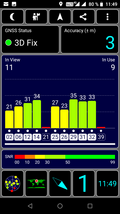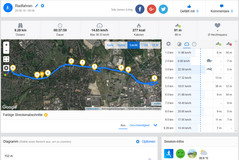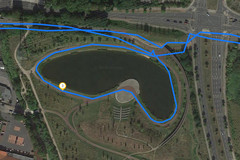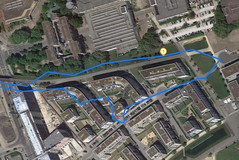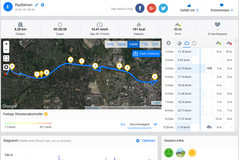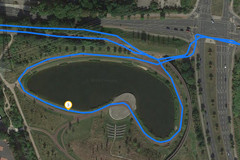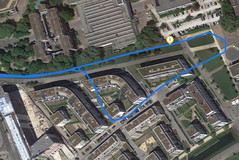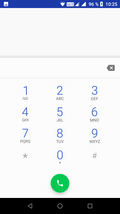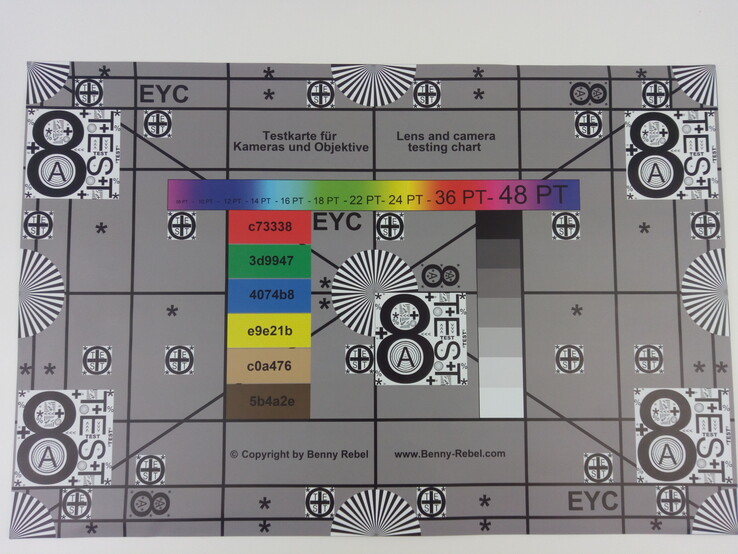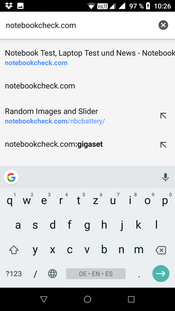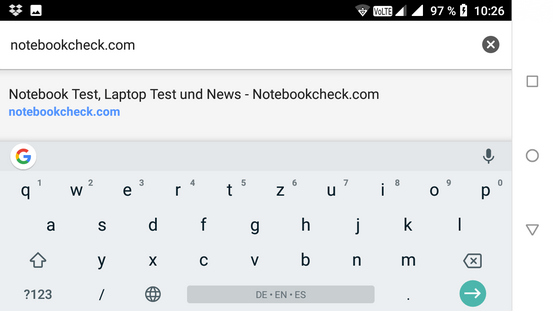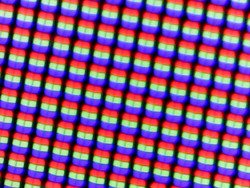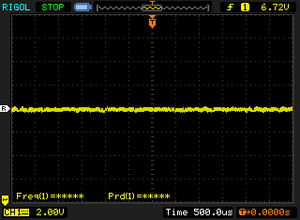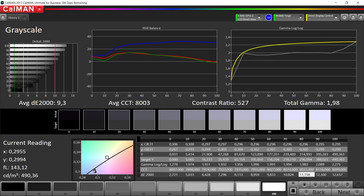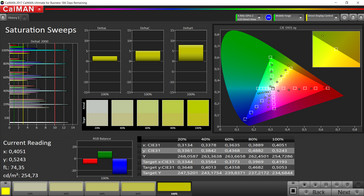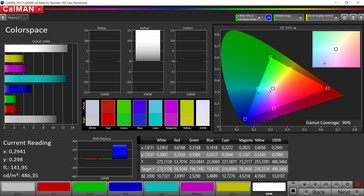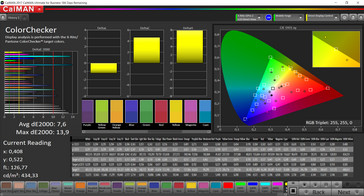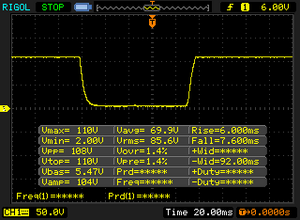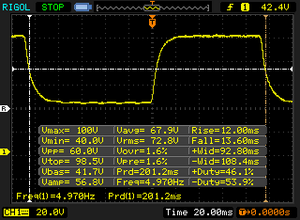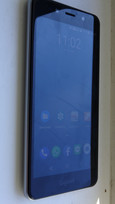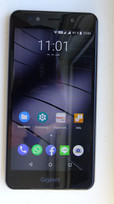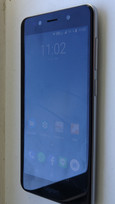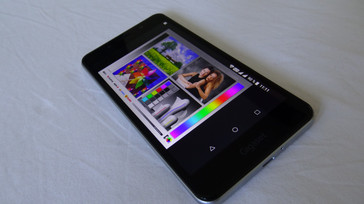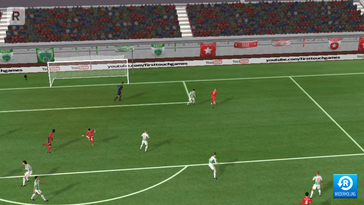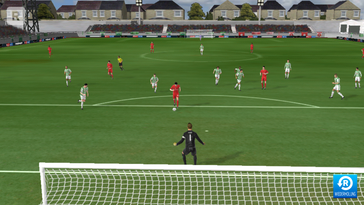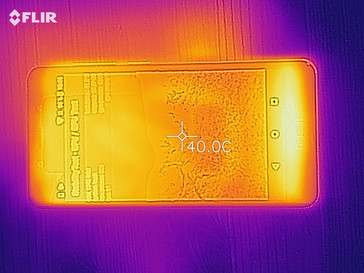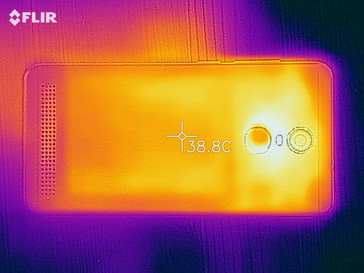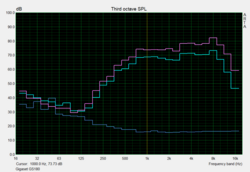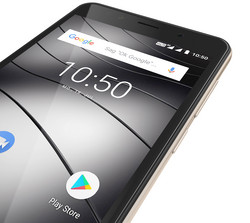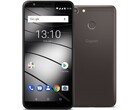Gigaset GS180 Smartphone Review
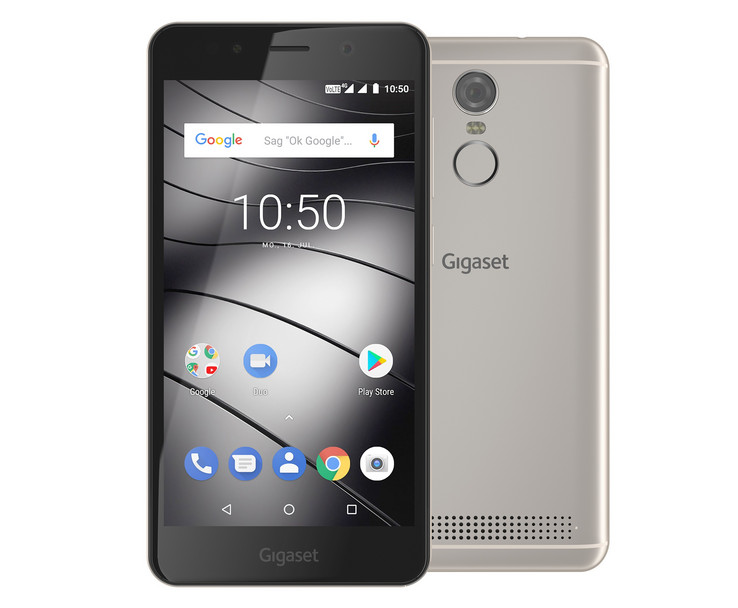
The Gigaset GS180 is very similar to the recently released Gigaset GS185 in many respects. For example, both smartphones support VoLTE, which is fairly uncommon for devices in this price range. However, unlike its 180-Euro (~$210) cousin the GS180 features a 5-inch 16:9 instead of the former’s 18:9 display. Given its resolution of 1280x720 the pixel density is 294 dpi - typical for its class.
Both Gigaset smartphones come with a vanilla flavor of Google’s most recent version of Android preloaded, 8.1 (Oreo). A fingerprint reader is also included, which is rather uncommon for devices in the sub-200-dollar price range.
The main difference between the two siblings is their design. While the Gigaset GS185 features a polycarbonate unibody case with non-removable battery the GS180 has a removable rear cover and, accordingly, a user-replaceable 3,000 mAh battery. Internal memory is 16 GB on both models, and according to the manufacturer it can be expanded via a microSD card of up to 128 GB.
The device is powered by a MediaTek MTK6737 quad-core processor running at just 1.3 GHz. It is paired with an ARM Mali-T720 MP1 GPU running at 550 MHz and 2 GB of RAM. The Gigaset GS185’s CPU is slightly faster at 1.4 GHz.
Both smartphones feature the exact same 13 MP camera capable of FHD video recording. The only difference is that the GS180’s aperture is f/2.2. Its secondary front-facing camera is just 8 MP, whereas the GS185’s features a 13 MP shooter at the front as well.
At an MSRP of 149 Euros (~$174), the GS180 is exactly 30 Euros (~$35) cheaper than the GS185, and it sold for 149 Euros at the time of writing. Both, the LG K8 and Nokia 3, can already be had for 105 Euros (~$123), while the Samsung Galaxy J3 costs 120 Euros (~$140). In all fairness, we should add though that these phones were all released in 2017.
Case
Unfortunately, the GS180’s case is not water- or dust-proof. The matte rear surface is slightly roughened and thus fingerprint resistant. In addition, the battery cover’s rough surface renders the phone pretty slip-proof on smooth table surfaces. The slots for the nano SIM and the microSD cards are located behind the battery cover, and all three can be accessed without removing the battery.
Volume rocker and power button can be found on the right-hand side, and we were positively surprised by the GS180’s low weight of just 137 g (4.83 oz). At just 148.5 x 70.8 x 8.2 mm (5.85 x 2.8 x 0.32 inches) it is also compact enough for one-handed use.
Connectivity
As already mentioned, the processor is a MediaTek’s MTK6737 - an entry-level SoC for Android smartphones that was first introduced in 2016. It has four 64-bit Cortex A53 cores running at 1.35 GHz. The GPU is an ARM Mali-T710 MP1 running at 550 MHz, and the SoC also features an LTE Cat. 4 modem, Wi-Fi 802.11 a/b/g/n, and a video decoder and encoder for 30 FPS FHD video.
Internal memory is just 16 GB, which is not uncommon for an entry-level smartphone. Fortunately, storage space can be expanded via microSD cards of up to 128 GB. In addition to the microSD card, the GS180 can also take two nano SIM cards simultaneously. It is charged via the Micro USB 2.0 port at the bottom of the device. This port can only be used for charging and data transfer, nothing else.
Software
Entry-level smartphones are mostly neglected in terms of operating system updates, but the Gigaset GS180 is different. It was the only device in our test group running Google’s most current version of Android, 8.1 Oreo.
Given that the operating system has remained largely unmodified save for two Gigaset apps, we expect a pretty long period of software updates. For some reason, Google Assistant was missing and had to be installed from the Play Store retroactively. Once installed it worked flawlessly.
Communication and GPS
The integrated Wi-Fi modem supports 802.11 a/b/g/n in the 2.4 and 5 GHz bands. At just 79.4 Mbps transfer rates when connected to our Linksys EA8500 reference router, the speeds were fairly low. Standing right next to a different router, an O2 HomeBox 2, RSSI read a comparatively low -32 dBm.
The phone supports LTE and VoLTE, although both are only supported on the first SIM card. The secondary SIM card can only access 3G/UMTS networks. Bluetooth 4.1 is included, NFC is not.
| Networking | |
| iperf3 transmit AX12 | |
| Gigaset GS180 | |
| Nokia 3 | |
| Samsung Galaxy J3 2017 | |
| LG K8 2017 | |
| iperf3 receive AX12 | |
| Gigaset GS180 | |
| Nokia 3 | |
| LG K8 2017 | |
| Samsung Galaxy J3 2017 | |
Positioning worked fairly well by and large, particularly outdoors. Indoor positioning was not as painless, but at 6 m (~20 ft), accuracy was okay for a device in this price range.
We took the GS180 on our usual bicycle tour in order to compare its GPS accuracy to a professional Garmin Edge 500 GPS. At exactly 9.28 km (~5.77 mi) the recorded track length was identical on both units. However, the actual track differed significantly between the two.
Telephone and Call Quality
The GS180 features Google’s standard phone app, which supports not just favorites, but also a list of recent conversations. Call quality was good, and we did not have any trouble understanding our conversational partners both indoors and outdoors, even in the comparatively poor Telefónica network. The integrated mono speaker rattled somewhat, but it was powerful enough and did not impede call quality on speakerphone.
The GS180’s flexibility is worthy of praise for sure. It can take two nano SIM cards at the same time. The first SIM card can connect to fast 4G/LTE networks, including support for VoLTE, the second SIM card has to make do with the slower 3G or even 2G networks. In addition to two nano SIM cards, the phone can also take an extra microSD card for storage expansion.
Cameras
The Gigaset GS180’s main camera features a 13 MP sensor and an aperture of f/2.2. Low light conditions were a serious challenge for the camera despite support for automatic HDR in auto mode. The powerful LED flash was a positive surprise.
The secondary camera is equipped with a smaller 8 MP sensor. Compared with other smartphones in its class the front-facing shooter’s photo quality was somewhat decent, however the photos lacked sharpness and details towards the edges.
We also test every camera under normalized conditions in our lab by taking a photo of a reference card simulating different and difficult conditions for cameras, such as for example fine lines on colored backgrounds.
As it turns out, the GS180’s main camera did not do particularly well in our test. Text on a red background was slightly blurry, the lines had color fringes along their edges, the photo seemed unevenly illuminated, and last but not least colors were oversaturated. All things considered the results were right where we would have expected them to be for a smartphone at the Gigaset’s price point.
Accessories & Warranty
We found the usual suspects in the Gigaset’s box: a charger with USB port, a USB cable, a stereo headset (not in-ear), and a quick start guide in seven European languages (one of them being German). The standard warranty is 24 months. Please see our Guarantees, Return policies and Warranties FAQ for country-specific information.
Input Devices & Handling
Like most current Android smartphones the GS180 features the usual three virtual buttons at the bottom of the display: back, home, and multi-tasking. When tapping on the multi-tasking button, a small broom that can be used to close all running applications appeared on the screen.
Another feature quite typical for pure Android smartphones is Google’s GBoard keyboard application. By default, it is set to the system language chosen during initial setup, but it also supports various other additional layouts - among others exotic ones like Galician or non-Latin typeface such as Japanese.
The display was a mixed bag. On the one hand its response times to tap input were fairly fast. On the other, its outdoor usability was severely limited due to massive reflections. Text input in portrait mode turned out to be very precise and accurate.
Display
The 5-inch IPS display runs at a resolution of 1280x720 pixels. Unlike many other modern smartphones, among others the Gigaset GS185, its display ratio is 16:9 instead of 18:9.
| |||||||||||||||||||||||||
Brightness Distribution: 87 %
Center on Battery: 478 cd/m²
Contrast: 531:1 (Black: 0.9 cd/m²)
ΔE ColorChecker Calman: 7.6 | ∀{0.5-29.43 Ø4.77}
ΔE Greyscale Calman: 9.3 | ∀{0.09-98 Ø5}
90% sRGB (Calman 2D)
Gamma: 1.98
CCT: 8003 K
| Gigaset GS180 IPS, 1280x720, 5" | Nokia 3 IPS, 1280x720, 5" | Samsung Galaxy J3 2017 PLS, 1280x720, 5" | LG K8 2017 IPS, 1280x720, 5" | |
|---|---|---|---|---|
| Screen | 46% | 49% | 8% | |
| Brightness middle (cd/m²) | 478 | 481 1% | 502 5% | 358 -25% |
| Brightness (cd/m²) | 510 | 469 -8% | 494 -3% | 351 -31% |
| Brightness Distribution (%) | 87 | 84 -3% | 89 2% | 93 7% |
| Black Level * (cd/m²) | 0.9 | 0.22 76% | 0.35 61% | 0.49 46% |
| Contrast (:1) | 531 | 2186 312% | 1434 170% | 731 38% |
| Colorchecker dE 2000 * | 7.6 | 8.1 -7% | 4.6 39% | 7.1 7% |
| Colorchecker dE 2000 max. * | 13.9 | 15.4 -11% | 8 42% | 14.9 -7% |
| Greyscale dE 2000 * | 9.3 | 8.5 9% | 2.5 73% | 6.5 30% |
| Gamma | 1.98 111% | 2.16 102% | 2.29 96% | 2.12 104% |
| CCT | 8003 81% | 9014 72% | 6351 102% | 8166 80% |
* ... smaller is better
Screen Flickering / PWM (Pulse-Width Modulation)
| Screen flickering / PWM not detected | |||
In comparison: 53 % of all tested devices do not use PWM to dim the display. If PWM was detected, an average of 8081 (minimum: 5 - maximum: 343500) Hz was measured. | |||
Its maximum brightness of 486 nits was acceptable for its price range, and maximum brightness remained unaffected by whether adaptive ambient light was enabled or disabled. In the real-world APL50 (Average Picture Level) test with evenly distributed bright and dark areas we were able to determine a maximum brightness of 478 nits in the middle as well as a black level of 0.9 nits.
In everyday use, colors were popping noticeably and the contrast ratio determined by us was okay for a device in this price range. sRGB color space coverage was also more than acceptable, and so were its DeltaE deviations for colors and grayscale as well as color temperature.
Display Response Times
| ↔ Response Time Black to White | ||
|---|---|---|
| 13.6 ms ... rise ↗ and fall ↘ combined | ↗ 6 ms rise | |
| ↘ 7.6 ms fall | ||
| The screen shows good response rates in our tests, but may be too slow for competitive gamers. In comparison, all tested devices range from 0.1 (minimum) to 240 (maximum) ms. » 33 % of all devices are better. This means that the measured response time is better than the average of all tested devices (20.2 ms). | ||
| ↔ Response Time 50% Grey to 80% Grey | ||
| 25.6 ms ... rise ↗ and fall ↘ combined | ↗ 12 ms rise | |
| ↘ 13.6 ms fall | ||
| The screen shows relatively slow response rates in our tests and may be too slow for gamers. In comparison, all tested devices range from 0.165 (minimum) to 636 (maximum) ms. » 34 % of all devices are better. This means that the measured response time is better than the average of all tested devices (31.6 ms). | ||
Outdoor usability was somewhat limited due to the display’s highly reflective nature, but it worked remarkably well indoors or in the dark. However, its ambient light sensor was rather slow, and by and large it went overboard and dimmed the display a bit too much for our taste. We recommend adjusting the brightness manually, especially when gaming.
Viewing angles were very wide thanks to IPS technology, and colors remained undistorted even at acute angles. However, the display darkened noticeably at extreme angles. Due to the comparatively low maximum brightness the display fell behind in bright ambient light conditions.
Performance
The Gigaset GS180 is powered by a 1.3 GHz MediaTek MTK6737 quad-core processor running at 1.3 GHz and 2 GB of RAM. In other words: it is adequately equipped for an entry-level smartphone. Accordingly, opening a new application with plenty of applications already running in the background took quite a while, and text input for example in Google Maps lagged somewhat behind.
| AnTuTu v7 - Total Score (sort by value) | |
| Gigaset GS180 | |
| LG K8 2017 | |
| Average Mediatek MT6737 (33984 - 36005, n=2) | |
| PCMark for Android | |
| Work performance score (sort by value) | |
| Gigaset GS180 | |
| Nokia 3 | |
| LG K8 2017 | |
| Average Mediatek MT6737 (2415 - 3624, n=18) | |
| Work 2.0 performance score (sort by value) | |
| Gigaset GS180 | |
| Nokia 3 | |
| Samsung Galaxy J3 2017 | |
| LG K8 2017 | |
| Average Mediatek MT6737 (2313 - 2768, n=13) | |
| GFXBench (DX / GLBenchmark) 2.7 | |
| T-Rex Onscreen (sort by value) | |
| Gigaset GS180 | |
| Nokia 3 | |
| Samsung Galaxy J3 2017 | |
| LG K8 2017 | |
| Average Mediatek MT6737 (6 - 14, n=17) | |
| Average of class Smartphone (12 - 166, n=153, last 2 years) | |
| 1920x1080 T-Rex Offscreen (sort by value) | |
| Gigaset GS180 | |
| Nokia 3 | |
| Samsung Galaxy J3 2017 | |
| LG K8 2017 | |
| Average Mediatek MT6737 (5.1 - 10, n=17) | |
| Average of class Smartphone (22 - 954, n=153, last 2 years) | |
| GFXBench 3.0 | |
| on screen Manhattan Onscreen OGL (sort by value) | |
| Gigaset GS180 | |
| Nokia 3 | |
| Samsung Galaxy J3 2017 | |
| LG K8 2017 | |
| Average Mediatek MT6737 (2.1 - 8, n=17) | |
| Average of class Smartphone (18 - 166, n=155, last 2 years) | |
| 1920x1080 1080p Manhattan Offscreen (sort by value) | |
| Gigaset GS180 | |
| Nokia 3 | |
| Samsung Galaxy J3 2017 | |
| LG K8 2017 | |
| Average Mediatek MT6737 (1.6 - 4.5, n=17) | |
| Average of class Smartphone (12 - 606, n=154, last 2 years) | |
| GFXBench 3.1 | |
| on screen Manhattan ES 3.1 Onscreen (sort by value) | |
| Gigaset GS180 | |
| Nokia 3 | |
| Samsung Galaxy J3 2017 | |
| LG K8 2017 | |
| Average Mediatek MT6737 (1.2 - 14, n=17) | |
| Average of class Smartphone (11 - 166, n=155, last 2 years) | |
| 1920x1080 Manhattan ES 3.1 Offscreen (sort by value) | |
| Gigaset GS180 | |
| Nokia 3 | |
| Samsung Galaxy J3 2017 | |
| LG K8 2017 | |
| Average Mediatek MT6737 (1.2 - 5.5, n=17) | |
| Average of class Smartphone (8.4 - 413, n=154, last 2 years) | |
| GFXBench | |
| on screen Car Chase Onscreen (sort by value) | |
| LG K8 2017 | |
| Average Mediatek MT6737 (n=1) | |
| Average of class Smartphone (5.5 - 154, n=157, last 2 years) | |
| 1920x1080 Car Chase Offscreen (sort by value) | |
| LG K8 2017 | |
| Average Mediatek MT6737 (n=1) | |
| Average of class Smartphone (3.5 - 239, n=156, last 2 years) | |
Overall, the GS180’s performance was average. Browsing performance was sufficient for an Android smartphone in its price range. Websites took quite a while to load, and scrolling was not always smooth.
| JetStream 1.1 - Total Score | |
| Samsung Galaxy J3 2017 (Chrome 59) | |
| LG K8 2017 (Chrome 57) | |
| Average Mediatek MT6737 (11.6 - 21.9, n=17) | |
| Nokia 3 (Chrome 59) | |
| Gigaset GS180 (Chrome 67) | |
| Octane V2 - Total Score | |
| Average of class Smartphone (2228 - 126661, n=195, last 2 years) | |
| LG K8 2017 (Chrome 57) | |
| Samsung Galaxy J3 2017 (Chrome 59) | |
| Gigaset GS180 (Chrome 67) | |
| Average Mediatek MT6737 (1730 - 3383, n=17) | |
| Nokia 3 (Chrome 59) | |
| Mozilla Kraken 1.1 - Total | |
| Gigaset GS180 (Chrome 67) | |
| Average Mediatek MT6737 (10615 - 30114, n=17) | |
| Nokia 3 (Chrome 59) | |
| Samsung Galaxy J3 2017 (Chrome 59) | |
| LG K8 2017 (Chrome 57) | |
| Average of class Smartphone (257 - 28190, n=155, last 2 years) | |
| WebXPRT 2015 - Overall | |
| Samsung Galaxy J3 2017 (Chrome 59) | |
| Nokia 3 (Chrome 59) | |
| Average Mediatek MT6737 (35 - 49, n=6) | |
* ... smaller is better
Internal store is limited to 16 GB - typical for its class. Considering the average size of modern apps that have grown in size quite dramatically over the past few years due to complex graphics 16 GB is nothing to write home about. On the plus side, the storage space can be expanded via microSD cards of up to 128 GB, and the phone can still take two nano SIM cards at the same time.
| Gigaset GS180 | Nokia 3 | Samsung Galaxy J3 2017 | LG K8 2017 | Average 16 GB eMMC Flash | Average of class Smartphone | |
|---|---|---|---|---|---|---|
| AndroBench 3-5 | -8% | 20% | 91% | 7% | 2448% | |
| Sequential Read 256KB (MB/s) | 154.1 | 181 17% | 177.7 15% | 270.8 76% | 164.5 ? 7% | 2246 ? 1357% |
| Sequential Write 256KB (MB/s) | 67.3 | 34 -49% | 51 -24% | 84.6 26% | 43 ? -36% | 1882 ? 2696% |
| Random Read 4KB (MB/s) | 12.5 | 17.7 42% | 24 92% | 41.6 233% | 21.7 ? 74% | 298 ? 2284% |
| Random Write 4KB (MB/s) | 9.73 | 5.5 -43% | 9.5 -2% | 12.5 28% | 8.08 ? -17% | 346 ? 3456% |
| Sequential Read 256KB SDCard (MB/s) | 64.3 | 70.3 | 78.6 ? | 59.1 ? | ||
| Sequential Write 256KB SDCard (MB/s) | 62.9 | 59.6 | 52.2 ? | 39.8 ? |
Gaming
The GPU is an ARM Mali-T720 MP1 running at 550 MHz. Accordingly, we expected modern games from Google’s Play Store such as “Dream League Soccer 2018” to run rather sluggishly on the Gigaset GS180’s GPU. Gaming is thus limited to simpler and less demanding titles such as “Angry Birds 2”.
Emissions
Temperature
Temperatures during daily use remained unobtrusive by and large. Under maximum load with CPU and GPU running our stress test for at least one hour the smartphone reached a maximum of 44.5 °C (~112 °F) at the top while large parts of its back remained below 40 °C (~104°F). The battery got slightly warm with many apps open at the same time.
(±) The maximum temperature on the upper side is 44.5 °C / 112 F, compared to the average of 35.2 °C / 95 F, ranging from 21.9 to 247 °C for the class Smartphone.
(±) The bottom heats up to a maximum of 40.9 °C / 106 F, compared to the average of 34 °C / 93 F
(±) In idle usage, the average temperature for the upper side is 33.3 °C / 92 F, compared to the device average of 32.9 °C / 91 F.
Speakers
The single mono speaker is located at the back of the device. Its maximum volume was okay for a device in this price range, and we liked its overall sound quality: it did not rattle or emit noticeable amounts of static while listening to music.
The acoustic pattern was fairly linear between 500 Hz and 7 kHz, however, it lacked bass and low mids. Highs above 8 kHz are well represented, but that is pretty much where the speaker topped out.
Plugging the included headset into the phone’s 3.5 mm headphone jack resulted in decent sound quality and an acceptable level of static and noise for the phone’s price range.
Gigaset GS180 audio analysis
(+) | speakers can play relatively loud (88.4 dB)
Bass 100 - 315 Hz
(-) | nearly no bass - on average 32.3% lower than median
(±) | linearity of bass is average (8.4% delta to prev. frequency)
Mids 400 - 2000 Hz
(+) | balanced mids - only 3.1% away from median
(+) | mids are linear (4.6% delta to prev. frequency)
Highs 2 - 16 kHz
(+) | balanced highs - only 4.3% away from median
(+) | highs are linear (4.5% delta to prev. frequency)
Overall 100 - 16.000 Hz
(±) | linearity of overall sound is average (19.8% difference to median)
Compared to same class
» 31% of all tested devices in this class were better, 8% similar, 61% worse
» The best had a delta of 11%, average was 35%, worst was 134%
Compared to all devices tested
» 50% of all tested devices were better, 7% similar, 43% worse
» The best had a delta of 4%, average was 24%, worst was 134%
Nokia 3 audio analysis
(+) | speakers can play relatively loud (86.5 dB)
Bass 100 - 315 Hz
(-) | nearly no bass - on average 39.4% lower than median
(±) | linearity of bass is average (11.6% delta to prev. frequency)
Mids 400 - 2000 Hz
(+) | balanced mids - only 4.8% away from median
(±) | linearity of mids is average (8% delta to prev. frequency)
Highs 2 - 16 kHz
(±) | higher highs - on average 5% higher than median
(+) | highs are linear (5.8% delta to prev. frequency)
Overall 100 - 16.000 Hz
(±) | linearity of overall sound is average (29% difference to median)
Compared to same class
» 76% of all tested devices in this class were better, 3% similar, 21% worse
» The best had a delta of 11%, average was 35%, worst was 134%
Compared to all devices tested
» 87% of all tested devices were better, 2% similar, 11% worse
» The best had a delta of 4%, average was 24%, worst was 134%
Battery Life
Power Consumption
Unfortunately, power consumption was not on comparable levels with the Nokia 3 and LG K8 (2017), neither when idle nor under load. The phone also lacks any form of rapid charging technology and thus took around 130 minutes to charge from near empty to 100%.
| Off / Standby | |
| Idle | |
| Load |
|
Key:
min: | |
| Gigaset GS180 3000 mAh | Nokia 3 2630 mAh | Samsung Galaxy J3 2017 2400 mAh | LG K8 2017 2500 mAh | Average Mediatek MT6737 | Average of class Smartphone | |
|---|---|---|---|---|---|---|
| Power Consumption | 23% | 6% | 18% | -5% | -32% | |
| Idle Minimum * (Watt) | 0.75 | 0.67 11% | 0.82 -9% | 0.65 13% | 0.869 ? -16% | 0.847 ? -13% |
| Idle Average * (Watt) | 1.88 | 1.35 28% | 1.94 -3% | 1.6 15% | 1.987 ? -6% | 1.446 ? 23% |
| Idle Maximum * (Watt) | 1.92 | 1.39 28% | 2.06 -7% | 1.62 16% | 2.11 ? -10% | 1.63 ? 15% |
| Load Average * (Watt) | 4.35 | 3.1 29% | 3.31 24% | 2.97 32% | 4.14 ? 5% | 6.95 ? -60% |
| Load Maximum * (Watt) | 5.02 | 4.02 20% | 3.89 23% | 4.34 14% | 4.94 ? 2% | 11.3 ? -125% |
* ... smaller is better
Battery Life
The battery is certainly one of the device’s weak points. While it is user replaceable, its capacity is fairly small at just 3,000 mAh. In our tests, the GS180 lasted for no more than 500 minutes. Translated into real life this means that the phone needs to be charged every single day. If you are looking for a phone with long battery life the GS185 with its 4,000 mAh battery might be worth a closer look.
| Gigaset GS180 3000 mAh | Nokia 3 2630 mAh | Samsung Galaxy J3 2017 2400 mAh | LG K8 2017 2500 mAh | |
|---|---|---|---|---|
| Battery runtime | ||||
| WiFi v1.3 (h) | 8.3 | 9.2 11% | 12 45% | 9.9 19% |
Pros
Cons
Verdict
The Gigaset GS180 shares some of its features with the more expensive Gigaset GS185: an up-to-date vanilla version of Android 8.1, 16 GB of storage space, dual SIM, VoLTE, and a fingerprint reader. In addition, its battery is replaceable. That is a lot of phone for 149 Euros (~$174).
The Gigaset GS180 shares some of its features with the more expensive GS185. If you can afford to spend another 30 Euros (~$35), we suggest buying the latter.
Nevertheless, we suggest buying the GS185 instead if you can afford to spend another 30 Euros (~$35). It has a bigger battery, a faster processor, and a better front-facing camera. Unfortunately, its display is also highly reflective and its ambient light sensor is just as slow.
Gigaset GS180
- 07/04/2018 v6 (old)
Thomas Meyer


